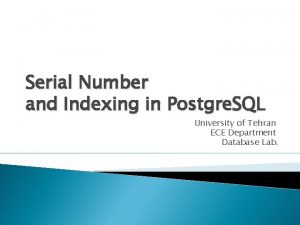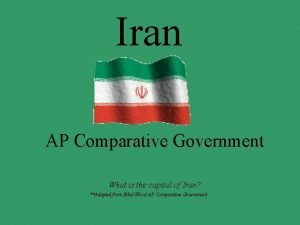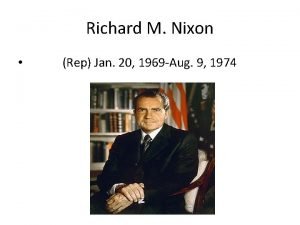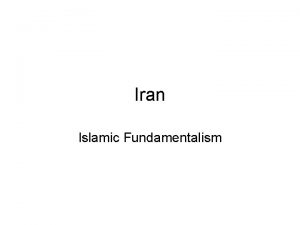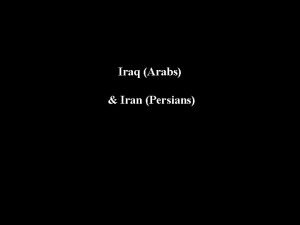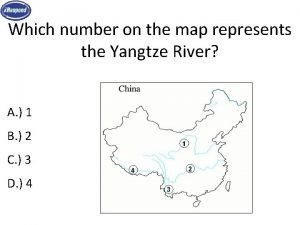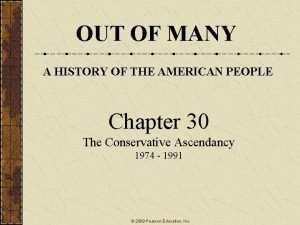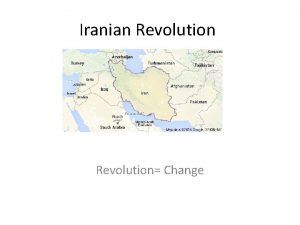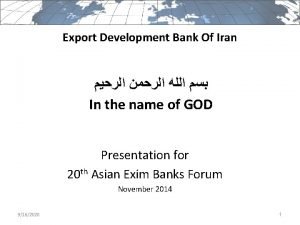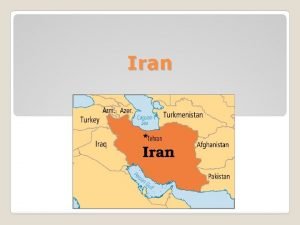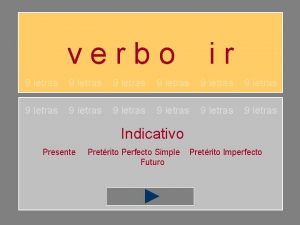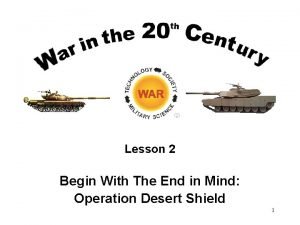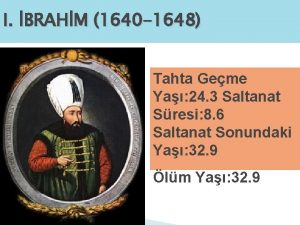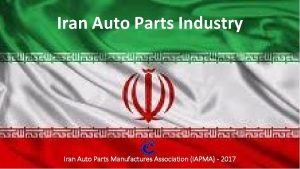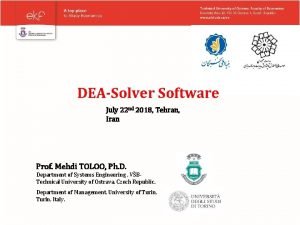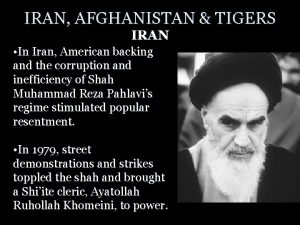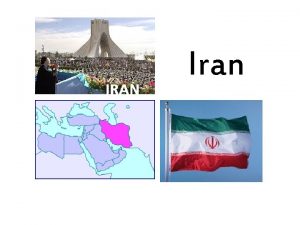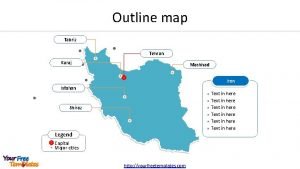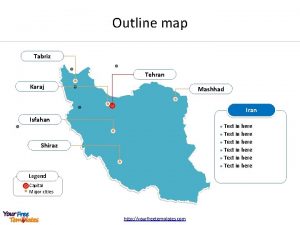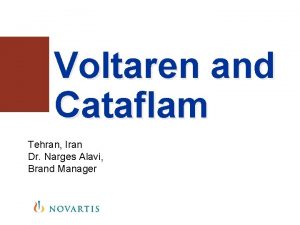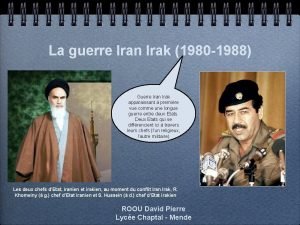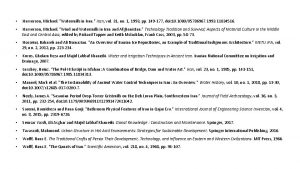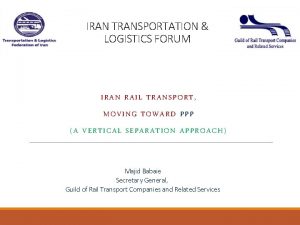Performance Evaluation July 22 nd 2018 Tehran Iran











































- Slides: 43

Performance Evaluation July 22 nd 2018, Tehran, Iran Prof. Mehdi TOLOO, Ph. D. Department of Systems Engineering , VŠBTechnical University of Ostrava, Czech Republic. Department of Management, University of Turin, Italy.

Resources Pr uc tiv Pr od ity uc tio n n fu Ec on o m y Ef fe ct iv Ef fi ci en enc es y s od 2

3

Introduction Doing thighs right (Efficiency) Doing right things (Effectiveness) 4

Efficient or Effective? 5

Value for Money (3 E) Value for Money is about providing services that are of the right quality, level and cost that reflect the needs and priority of customers. § Efficiency: performing tasks with reasonable effort. (doing things right) § Effectiveness: the extent to which objectives are met. (doing the right things) § Economy: minimizing the cost of resources. (doing things at a low price) Efficiency + Economy= a low-cost strategy, where the cost of sale is driven low to allow competition on price alone. (doing things right at a low price) Efficiency + Effectiveness= a premium strategy, giving the customer a right (smooth) delivery of what they want, but at a price. (doing rightly the things right) Economy + Effectiveness=a budget strategy, with customers getting most of what they want at a price that seems very good value. (doing the things right at a low price) Efficiency + Effectiveness + Economy=an Excellence strategy, giving the customer a right delivery of what they want at a price that seems very good value. (doing rightly the things right at a low price) 6

3 E’s diagram Efficiency Lo ium m e Pr wco st Economy Budget EXCELLENCE Effectiveness 7

Strategic Management Effectiveness Efficiency Operational Management Efficiency vs. Effectiveness Die Quickly Die Slowly Survive Thrive 8

If you can not measure it, you can not improve it. 9

3 E’s diagram Outcomes Revenue ss ne ve cti fe Ef y om on Ec Ec on om y Cost Efficiency Inputs Outputs 10

Inputs – Outputs in banking industry Mostafa (2009) 11

Flexible measures & Dual-role factors 12

Efficiency and Effectiveness Bank Production Process Employee Assets Equity Market Value Revenues Marketability Profits Returns Earning per share 13

What is DEA approach? • Data Envelopment Analysis (DEA) is a mathematical quantitative approach for measuring the performance of a set of homogeneous Decision Making Units (DMUs). • In engineering applications, DMUs may take such forms as airplanes, technology, facility layout, power plant, data mining. • In managerial applications, DMUs may include banks, department stores and supermarkets, and extend to car makers, hospitals, schools, public libraries. • Each DMU uses multiple inputs to produce multiple outputs. • DEA is a data-oriented method and hence the data (performance measures) play an important role in the obtained efficiency scores. 14

Inputs and Outputs in DEA • Smaller input amounts are preferable. • Larger output amounts are preferable. • I/O should reflect an analyst's or a manager's interest in the components that will enter into the relative efficiency evaluations of the DMUs. 15

Case study 1 Hospitals Staff Patients H 1 173 222 H 2 280 240 H 3 225 212 H 4 246 297 H 5 173 248 H 6 323 316 H 7 253 342 H 8 212 362 H 9 197 353 H 10 190 370 H 11 270 350 H 12 250 362 H 5 dominates H 1 H 8 dominates H 12 16

Efficiency Hospitals Staff Patients/Staff Normalized H 1 173 222 1. 283 0. 659 H 2 280 240 0. 857 0. 440 H 3 225 212 0. 942 0. 484 H 4 246 297 1. 207 0. 620 H 5 173 248 1. 434 0. 736 H 6 323 316 0. 978 0. 502 H 7 253 342 1. 352 0. 694 H 8 212 362 1. 708 0. 877 H 9 197 353 1. 792 0. 920 H 10 190 370 1. 947 1 H 11 270 350 1. 296 0. 666 H 12 250 362 1. 448 0. 744 Efficiency= Patients Staff 17

Geometric interpretation Efficient frontier envelops all data. The name Data Envelopment Analysis (DEA), comes from this property 18

Input and output orientations 19

Generalization x 1 xn DMU 1 DMUn y 1 yn eo contains two important properties: 1. units invariant 2. constant returns-to-scale (CRS) 20

Case study 2: (2 Ins and 1 Out) Inputs Hospitals Output Normalized Inputs Unitized Output efficiency Doctors Nurses Patients D/P N/P P/P H 1 25 148 222 0. 113 0. 667 1 0. 677 H 2 46 234 240 0. 192 0. 975 1 0. 441 H 3 32 193 212 0. 151 0. 910 1 0. 499 H 4 39 207 297 0. 131 0. 697 1 0. 624 H 5 23 150 248 0. 093 0. 605 1 0. 769 H 6 36 287 316 0. 114 0. 908 1 0. 542 H 7 50 203 342 0. 146 0. 594 1 0. 724 H 8 16 196 323 0. 050 0. 607 1 1 H 9 21 176 353 0. 059 0. 499 1 1 H 10 31 159 370 0. 084 0. 430 1 1 H 11 45 225 350 0. 129 0. 643 1 0. 668 H 12 43 207 362 0. 119 0. 572 1 0. 752 Staff Doctors Nurses 21

Geometric interpretation 22

Efficiency value 23

Case study 3 (1 In & 2 Outs) Inpatients Outpatients S/S I/S O/S Efficiency Normalized output Hospitals Unitized input Staffs H 1 H 2 H 3 H 4 H 5 H 6 H 7 H 8 H 9 H 10 H 11 H 12 173 280 225 246 173 323 253 212 197 190 270 250 33 65 70 63 87 91 84 68 33 75 73 69 189 175 142 234 161 225 258 294 320 295 277 293 1 1 1 0. 191 0. 232 0. 311 0. 256 0. 503 0. 282 0. 332 0. 321 0. 168 0. 395 0. 270 0. 119 1. 092 0. 625 0. 631 0. 951 0. 931 0. 697 1. 020 1. 387 1. 624 1. 553 1. 026 0. 572 0. 687 0. 513 0. 634 1 0. 606 0. 766 0. 887 1 1 0. 675 0. 751 Input Outputs Patients Inpatients Outpatients 24

Geometric interpretation 25

General Case Hospital Inputs Outputs Doctors Nurses Inpatients Outpatients H 1 25 33 189 H 2 Staff 148 46 234 H 3 32 193 H 4 39 H 5 23 H 6 36 H 7 50 Nurses 203 H 8 16 196 68 294 H 9 21 176 33 320 H 10 31 159 75 295 H 11 45 225 73 277 H 12 43 207 69 293 Doctors 207 150 287 Patients 65 175 70 142 63 234 87 161 91 225 Inpatients 84 Outpatients Let v 1: weight for Doctors. v 2: weight for Nurses. u 1: weight for Inpatients. u 2: weight for Outpatients. For example: v 1=5, v 2=1, u 1=1, u 2=4 258 26

Various common weights Hospitals (v 1, v 2, u 1, u 2)= CSW (5, 1, 1, 4) (2. 5, . 3, 1. 5, 4. 5) (0. 3, 1, . 3, 1) H 1 0. 619 0. 584 0. 678 0. 662 H 2 0. 353 0. 331 0. 416 0. 440 H 3 0. 387 0. 374 0. 426 0. 486 H 4 0. 532 0. 498 0. 613 0. 621 H 5 0. 590 0. 578 0. 632 0. 741 H 6 0. 454 0. 452 0. 449 0. 509 H 7 0. 527 0. 480 0. 689 H 8 0. 965 1 0. 830 0. 895 H 9 1 0. 981 0. 959 0. 932 H 10 0. 855 0. 797 1 1 H 11 0. 562 0. 522 0. 664 0. 665 H 12 0. 629 0. 581 0. 756 0. 742 sum 7. 473 7. 180 8. 113 8. 382 Let xij: the ith input of DMUj yrj: the rth output of DMUj It is not clear how much of the efficiency ratings are due to the weights and how much inefficiency is associated with the observations 27

Variable weights approach Hospitals v 1 v 2 u 1 u 2 CCR H 1 0. 180 0. 645 0. 000 0. 367 0. 693 H 2 0. 000 0. 427 0. 586 0. 081 0. 523 H 3 0. 000 0. 518 0. 711 0. 098 0. 638 H 4 0. 991 0. 296 0. 538 0. 127 0. 636 H 5 1. 473 0. 441 0. 799 0. 189 1 H 6 2. 315 0. 058 0. 712 0. 000 0. 648 H 7 0. 000 0. 493 0. 676 0. 094 0. 809 H 8 3. 688 0. 209 0. 660 0. 188 1 H 9 1. 199 0. 425 0. 282 0. 283 1 H 10 1. 260 0. 383 0. 692 0. 163 1 H 11 0. 000 0. 444 0. 610 0. 084 0. 679 H 12 0. 000 0. 483 0. 000 0. 260 0. 763 28

DEA model 25 148 43 207 33 H 1 189 69 H 12 293 29

Generalization for multi-input and multi-output case x 11 xm 1 y 11 DMU 1 x 1 n xmn ys 1 y 1 n DMUn ysn 30

Charnes, Cooper, Rhodes (1978) “The CCR model ” Fractional Linear Programming 31

The CCR model related to DMU 1 Definition: DMUo is CCR-efficient if and only if eo*=1; otherwise is CCR-inefficient 32

Solving DEA Models COMERCIAL DEA SOFTWARE • DEA-Solver-PRO • Frontier Analyst • On. Fornt • Performance Improvement Management Software (PIM-DEA) • Kon. Si NON-COMERCIAL DEA SOFTWARE • DEA-Solver-LV • Excel Solver • DEAP • EMS • PIONEER 2 OPTIMIZATION SOFTWARE • GAMS (www. gams. com) • LINDO (www. lindo. com) 33

How to apply the DEA approach 1. Find a problem: Ø Ø Ø Robot Selection Problem, Baker and Talluri 1995. Computer Numerical Control Machine Selection, Sun 2002. Technology Selection Problem, Karska and Ahiska 2005. Discovered Association Rules Selection from Data Mining Toloo et al. 2009. Financing decision problem Toloo and Kresta 2014. 2. Gather the important data: Ø Banks’ performance evaluation (Employees, Expenses, Assets, Loans, Deposits, Income) 3. Determine inputs and outputs: 4. Select a suitable DEA model: Ø CRS, VRS, IRS, DRS, Radial, non-radial, Additive , SBM, Hybrid 5. Select a software: Ø DEA-Solver, Excel-Solver, GAMS 6. Analyze the results. 7. Set targets and adopt a policy for acquiring the targets. 34

DEA models Radial & Non-radial DEA models Oriented & Non-oriented Hybri d 35

Radial & Oriented model: CCR 36

Radial & Oriented model: BCC 37

Non-radial & Non-oriented model: Additive 38

Non-radial & Non-oriented model: Slacks-Based Measure (SBM) 39

Hybrid model 40

Relation between different DEA Models • 41

Summary of DEA Models Characteristics 42

Thank you for attention
 Conus arteriosus
Conus arteriosus Tehran hash download
Tehran hash download Drama3d
Drama3d Periprostetic
Periprostetic Tehran conference apush
Tehran conference apush B a f c j e
B a f c j e Marzano teacher evaluation scale
Marzano teacher evaluation scale Piezometer groundwater
Piezometer groundwater Iran prebivalstvo
Iran prebivalstvo Mosadek iran
Mosadek iran Razboiul dintre iran si irak
Razboiul dintre iran si irak Estudio bíblico sobre el infierno y el lago de fuego
Estudio bíblico sobre el infierno y el lago de fuego Capitalof iran
Capitalof iran William knox d'arcy
William knox d'arcy Iran contra affair
Iran contra affair Where did the shepherd live in iran
Where did the shepherd live in iran I must go home to iran again
I must go home to iran again Azerbaycan yatırım teşvikleri
Azerbaycan yatırım teşvikleri Persian cat map
Persian cat map Sistagma
Sistagma Iran
Iran Which number on the map represents the country of kuwait?
Which number on the map represents the country of kuwait? Oliver north iran contra affair
Oliver north iran contra affair Iran doostan
Iran doostan Iran religion
Iran religion Parsi language
Parsi language When did iran gain independence
When did iran gain independence Satrapy of iran
Satrapy of iran Export development bank of iran
Export development bank of iran Dba iran
Dba iran Persia 1935
Persia 1935 Iran cyber
Iran cyber Voy vas va vamos van
Voy vas va vamos van Language in iran
Language in iran Manouchehr khosrodad
Manouchehr khosrodad Iran population
Iran population Local guide program
Local guide program Iran hostage crisis timeline
Iran hostage crisis timeline Alabanza el rapto de la iglesia
Alabanza el rapto de la iglesia Iranian anthem lyrics
Iranian anthem lyrics Pul islohatlari
Pul islohatlari Persian crown jewels
Persian crown jewels The voice iran
The voice iran Iran auto parts
Iran auto parts

